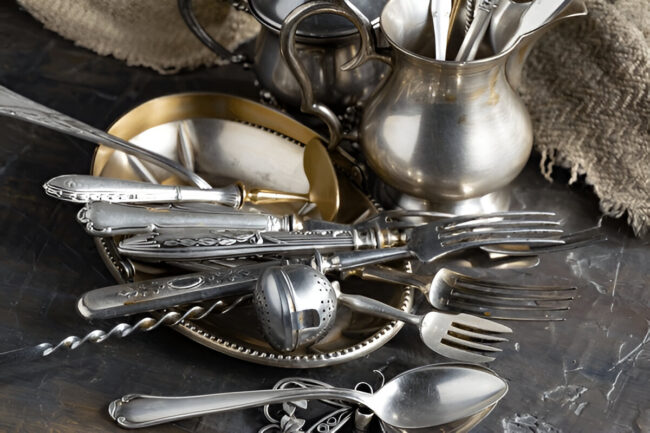
There’s something timeless about the glow of silver. Whether it’s a delicately engraved tea set, a pitcher repurposed as a vase, or a gleaming tray that’s been passed down for generations, silver carries with it beauty, history, and a touch of ceremony. But for anyone starting to collect—or even simply admire—antique silver sets, one key question always arises: how can you tell if it’s real?
At Silver Perfect, we believe understanding the differences between sterling silver, coin silver, and silver plate helps collectors make informed choices and appreciate the artistry behind every piece. Knowing how silver was made, and what it took to produce it, gives the owner a deeper appreciation of not just the object itself, but the people and techniques that brought it to life.
The Basics: Sterling, Coin Silver, and Silver Plate
Let’s start with a foundation. Solid silver falls into two main categories: sterling silver and coin silver.
Sterling silver is what most people are familiar with today. It’s made from an alloy of 92.5% silver and 7.5% other metals—usually copper—which gives it strength while retaining that brilliant, unmistakable gleam. Sterling silver will often be marked “925” or stamped “STERLING,” especially in American pieces made after the mid-19th century.
Coin silver, on the other hand, is a little older—and a little rarer. Before the United States adopted the sterling standard, silversmiths would often melt down coins to create silver objects. This resulted in a purity closer to 90%, and these items are commonly marked “COIN” or “PURE COIN.” At Silver Perfect, we’ve handled many of these historic pieces. One telltale sign? Coin silver often shows firescale, a purplish, blotchy surface that appears when the silver is exposed to high heat. While some might see it as a flaw, we see it as character—evidence of age and authenticity.
And then there’s silver plate—not solid silver, but base metal (often copper or nickel) covered with a thin layer of silver through electroplating. While plated pieces can look beautiful, they lack the intrinsic value of solid silver and wear down over time. Collectors often seek out the real thing, both for its durability and long-term value.
Simple Ways to Tell the Difference
Over the years, we’ve shared a few tried-and-true methods to help people distinguish between silver types:
- Look for marks: Solid silver is usually hallmarked. In American pieces, look for “STERLING” or “925.” English silver features the lion passant and date letters. Coin silver may be marked “COIN,” though early examples sometimes lack marks altogether. Silver plate is often marked “EPNS” (Electroplated Nickel Silver) or similar.
- Listen to the sound: One of our favorite tricks? Tap the item gently with your finger or a piece of wood. Solid silver rings—it has a lovely, bell-like tone. Silver plate gives off a dull thud. It’s subtle, but once you’ve heard both, you’ll notice the difference.
- Feel the weight: Solid silver has a density that silver plate often lacks. A sterling fork or spoon will feel a bit heavier and more balanced than a plated equivalent.
- Check for wear: With plated items, you may see base metal showing, especially on the back of forks or the bottom of trays. If you spot a brassy or coppery color underneath, it’s likely not solid silver.
The Collector’s Eye: Why Real Silver Matters
While some people are perfectly happy with the look of silver plate, serious collectors almost always prefer solid silver. At Silver Perfect, we look at each piece not just for its material, but for what it took to make it.
Was it hand-hammered? Spun on a lathe? Chased and engraved by a skilled artisan?
Silver isn’t just beautiful, it’s labor-intensive. Tiffany and Gorham, two of the most respected American silversmiths, used techniques like acid etching to create intricate patterns and textures. Others relied on traditional hammering, spinning, and repoussé work to shape and decorate their pieces. When you hold a teapot or candlestick that took dozens of hours to craft, you’re holding far more than metal—you’re holding someone’s legacy.
The Humble, Creative Joy of Silver at Home
There’s no rulebook when it comes to enjoying silver. In fact, we often encourage our customers to think outside the box.
Grab a pitcher and put flowers in it.
Use a footed bowl to hold lemons on the counter.
Stack antique silver trays in your entryway to catch mail and keys.
Silver isn’t just for formal dinners—it’s for everyday beauty. When you use it, polish it, and live with it, you’re continuing a tradition that goes back hundreds of years.
Caring for Your Antique Silver Sets
Whether you’re dealing with sterling, coin silver, or silver plate, a little care goes a long way.
- Wash by hand with a mild detergent—Palmolive is one of our go-to choices. Avoid dishwashers and abrasive cleaners.
- Dry immediately with a soft cloth to avoid water spots and tarnish.
- Store pieces in a dry, low-humidity environment, ideally in tarnish-resistant bags or cloth.
- Avoid over-polishing. Silver is meant to age gracefully—sometimes a little patina adds to the charm.
Passing Silver from Hand to Hand
One of the most profound truths about antique silver is that we rarely keep it forever. When owners are long gone, pieces change hands, and we’re reminded that we are just caretakers for a moment in time.
There’s beauty in that. A teapot that once belonged to a Victorian family may now sit on your table. A Tiffany tray gifted for a wedding in 1901 could be the centerpiece at your next dinner party.
We once found a piece gifted by Queen Victoria to one of her generals, engraved with her royal cypher. That one small inscription dramatically increased its value and historical significance. Years later, it resurfaced and sold at a much higher price. These are the stories that make silver more than just decoration; they make it treasure.
Bringing It All Together
At the end of the day, silver collecting isn’t about perfection—it’s about passion. It’s about appreciating the feel of real silver in your hand, the ring of it when tapped, the soft gleam of an antique finish. It’s about honoring the work that went into its creation and recognizing the legacy it carries.
At Silver Perfect, we specialize in antique silver sets that are beautiful, authentic, and meaningful. Whether you’re just starting your collection or looking for your next showpiece, we invite you to explore our curated selection—and bring home a piece of history that will shine for generations to come.
